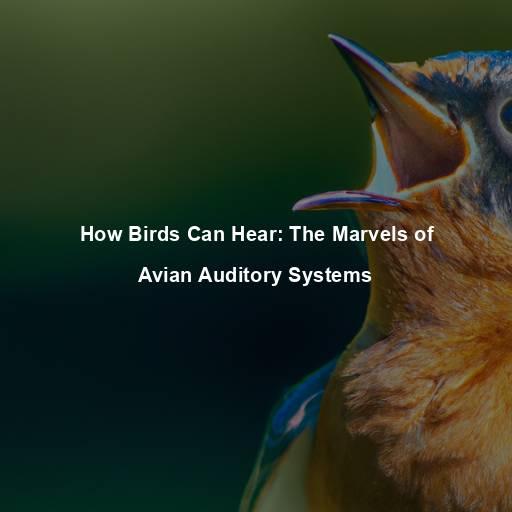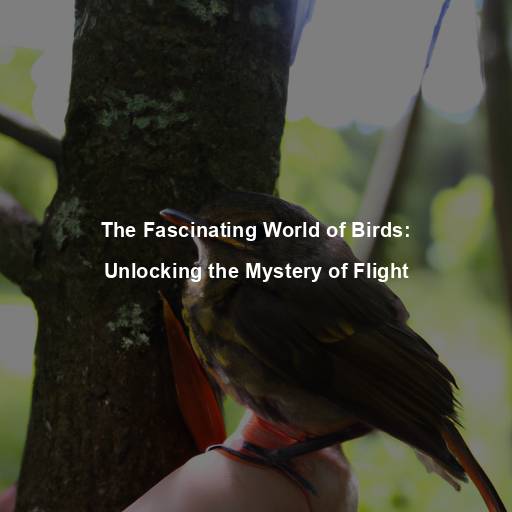How Birds Can Hear: The Marvels of Avian Auditory Systems
Last Updated on July 22, 2023 by Evan
Contents
- 1 Understanding the Complexity of Avian Hearing
- 2 The Anatomy of Avian Ears
- 3 The Cochlea: Unraveling the Secrets of Avian Hearing
- 4 The Unique Capabilities of Avian Hearing
- 5 The Importance of Understanding Avian Hearing
- 6 A Symphony of Sound: Celebrating Avian Auditory Splendor
- 7 Hearing in Avian Navigation and Foraging
- 8 The Impact of Human Noise Pollution on Avian Hearing
- 9 Celebrating the Richness of Avian Hearing
- 10 FAQs – How Birds Can Hear
- 10.1 How do birds hear?
- 10.2 What is the role of the outer ear in bird hearing?
- 10.3 How does sound travel from the outer ear to the inner ear in birds?
- 10.4 What is the function of the middle ear in bird hearing?
- 10.5 How does hearing happen in the inner ear of birds?
- 10.6 Can birds hear better than humans?
- 10.7 Do all birds have the same level of hearing?
- 10.8 Can loud sounds or noise harm birds’ hearing?
Understanding the Complexity of Avian Hearing
The world of birds is filled with fascinating wonders, from their vibrant plumage to their intricate songs. However, one aspect that often goes unnoticed is their remarkable auditory system. Birds possess an extraordinary ability to perceive and interpret sounds, allowing them to navigate their environment, communicate, and engage in complex behaviors. In this article, we will delve into the intricacies of avian hearing, exploring the mechanisms that enable birds to hear and appreciate the beauty of their acoustic world.
The Anatomy of Avian Ears
Birds, with their enchanting melodies and graceful flights, possess an auditory system that remains cloaked in intrigue. The perplexing wonder lies not just in their vibrant voices, but also in the enigmatic design of their ears. Unlike our own, these feathered creatures lack external ears or pinnae, leaving their auditory apparatus tucked away beneath layers of soft plumage. Their ears, shrouded in the mysteries of nature, comprise a trinity of intricately woven components – the uncanny outer ear, the enigmatic middle ear, and the elusive inner ear.
The Outer Ear: A Different Approach
In birds, the outer ear takes the form of a small opening known as the external auditory meatus. This opening leads to the ear canal, which is lined with specialized feathers that aid in sound reception. These feathers, called auricular feathers, direct sound waves towards the ear canal, amplifying the incoming sounds and enhancing their detection.
The Middle Ear: Transmitting Sound
Have you ever wondered about the intriguing similarities between the middle ear of birds and humans? It’s mind-boggling how both species share common elements like the eardrum and the tiny but mighty ossicles. When sound waves dance their way into the bird’s ear canal, an enchanting symphony unfolds as the eardrum begins to quiver rhythmically. As if not satisfied with the mere vibration, the ossicles join in, embellishing the sound even more before gracefully delivering it to the inner ear.
The Inner Ear: The Gateway to Perception
Discover the mesmerizing world hidden within the avian creatures, where astonishing wonders unfold. Immerse yourself in the intricate labyrinth of the inner ear, a realm adorned with fluid-filled chambers and delicate sensory structures that unravel the enigma of translating vibrations into ethereal melodies. Among this symphony of auditory marvels lies the cochlea, a beacon of perception that ignites the essence of sound within these enchanting beings. Delve into the depths of this magical soundscape and embark on a journey to unlock the secrets of avian auditory prowess.
The Cochlea: Unraveling the Secrets of Avian Hearing
Nestled within the intricate inner ear lies the enigmatic cochlea, a spiral-shaped marvel that exudes mystery. Its secretive allure lies in the thousands of microscopic hair cells that adorn its walls, like tiny guardians of sound. These elusive receptors possess the extraordinary power to transmute the ethereal vibrations of the world into enigmatic electrical signals, defying conventional understanding. Through their mystifying alchemy, these signals embark on an enigmatic journey, traversing the auditory nerve, unraveling the secrets of sound to the curious depths of the human brain.
Avian Hair Cells: A Symphony of Sensitivity
What makes avian hair cells truly remarkable is their sensitivity to different frequencies. Unlike humans, who primarily have hair cells that respond to a specific range of frequencies, birds possess a diverse array of hair cells that are finely tuned to different frequencies. This allows birds to perceive a wide range of sounds, from the melodic songs of their fellow avians to the subtle rustling of leaves.
The Avian Auditory Pathway: A Journey to Perception
Once the electrical signals are generated by the hair cells, they travel along the auditory nerve to the brainstem. From there, the signals are relayed to various auditory processing centers in the brain, where they are analyzed and interpreted. This intricate pathway enables birds to recognize and distinguish between different sounds, facilitating their ability to communicate and navigate their surroundings.
The Unique Capabilities of Avian Hearing
Now that we have explored the anatomy and mechanisms of avian hearing, let us delve into the unique capabilities of birds’ auditory systems.
Ultrasonic Hearing: Beyond Human Perception
While humans can only hear sounds within a limited frequency range, birds possess the extraordinary ability to perceive ultrasonic frequencies. Some species of birds, such as certain owls and swiftlets, can detect ultrasonic sounds that are completely inaudible to human ears. This enables them to communicate and locate prey in ways that are beyond our comprehension.
Directional Hearing: A 360-Degree Soundscape
Birds also excel in their ability to discern the direction of sounds. Their ears are strategically positioned on the sides of their heads, allowing them to localize sounds with remarkable accuracy. This directional hearing is vital for birds to detect potential threats, locate prey, and communicate with other members of their species, enhancing their chances of survival in the wild.
Vocal Mimicry: A Symphony of Imitation
Many bird species are renowned for their exceptional vocal mimicry skills. From the iconic mockingbird to the enchanting lyrebird, these avian virtuosos can imitate a wide array of sounds, including the songs of other birds, human speech, and even the sounds of their environment. This remarkable ability showcases the intricacies of their auditory perception and the complexity of their vocal repertoire.
The Importance of Understanding Avian Hearing
Delving into the intricate world of avian biology through the exploration of their auditory prowess unlocks a trove of awe-inspiring discoveries. Unraveling the evolutionary adaptations that have sculpted these captivating creatures not only captivates our minds but also holds the key to invaluable insights. Moreover, peering into the realm of avian sound perception goes beyond mere fascination, as it holds the potential to aid in the conservation of these feathered beings. By assessing the detrimental impact of human-generated noise pollution on avian populations, we can pave the way for proactive strategies to minimize its perplexing effects.
A Symphony of Sound: Celebrating Avian Auditory Splendor
As we come to the end of our journey into the realm of avian hearing, we are left in awe of the astonishing intricacies that define the acoustic landscape in which birds dwell. It is truly a marvel to witness their remarkable capacity to perceive and decipher a symphony of sounds, a testament to the enigmatic wonders of nature and the remarkable adaptations that have enabled avian species to flourish in every corner of our vast world. So, the next time you find yourself captivated by the ethereal melodies of a bird’s melodic composition, pause for a moment and revel in the sheer beauty and complexity of the auditory tapestry unfolding before your very ears.
Birds, those fascinating creatures of the sky, have a secret language that captivates our imagination. Their ability to communicate through sound is a marvel worth exploring. As we peer into the intricate world of avian auditory abilities, we uncover the hidden songs and calls that bind these feathered beings together in a symphony of communication. Join us on this exhilarating journey as we unlock the perplexing code of avian interaction.
Vocalizations: The Language of Birds
Birds employ a wide range of vocalizations to convey messages and establish territories, attract mates, defend their nests, and communicate within their social groups. These vocalizations vary greatly in pitch, rhythm, and complexity, reflecting the diversity of avian species and their unique ecological niches.
Songbirds: The Maestros of Melody
Songbirds, such as thrushes, warblers, and finches, are renowned for their melodious and intricate songs. These avian virtuosos have the ability to produce complex sequences of notes, often with remarkable precision and consistency. Their songs serve multiple purposes, from attracting mates and defending territories to signaling aggression or submission.
Calls: The Expressive Chirps and Chirrups
Birds, those fascinating creatures of the sky, possess a remarkable repertoire of communication beyond their harmonious melodies. Their calls, like fragments of a sonic language, range from delightful chirps and trills to intricate alarm signals, friendly contact calls, and cautionary warnings. Each call, imbued with intention, serves as a messenger from the avian realm, relaying crucial information about looming dangers, enticing food havens, or the lurking presence of fierce predators. With each vocal utterance, a hidden world unfolds, captivating us with their burst of expression and perplexing depth.
Non-vocal Communication: Beyond Words
While vocalizations are the primary means of avian communication, birds also employ non-vocal signals to convey messages. These non-vocal signals include visual displays, such as elaborate courtship dances, feather displays, and territorial postures. Some species even utilize synchronized wingbeats or elaborate plumage patterns to communicate dominance or attract mates.
Beyond communication, avian hearing plays a crucial role in navigation and foraging. Birds rely on their auditory senses to locate food sources, navigate through complex environments, and orient themselves during long migrations.
Some species of birds, such as certain owls and nightjars, possess the ability to echolocate. Similar to bats, these birds emit high-frequency sounds and use the echoes to determine the location and distance of objects in their surroundings. Echolocation allows them to navigate through dense forests, locate prey, and avoid obstacles in low-light conditions.
Foraging by Sound: A World of Whispers
It’s fascinating how birds have honed their foraging techniques to capitalize on the auditory wonders of their surroundings. They’ve unlocked the secret to deciphering the gentle whispers of leaves or the faint stirrings of insects, using these elusive sounds as a compass to guide them towards their next delicious treat. With this remarkable ability, our feathered friends have unlocked a skill that sets them apart from other creatures, granting them an edge in the relentless quest for food.
Magnetic Orientation: A Sense of Direction
The extraordinary phenomenon of migratory birds relying on the Earth’s magnetic field for navigation continues to baffle scientists. Despite the ongoing research, the underlying mechanisms of this magnetic sense remain shrouded in mystery. It is widely surmised that birds possess an innate capability to perceive the minute fluctuations in magnetic fields, enabling them to effortlessly find their way during their awe-inspiring long-haul journeys.
The Impact of Human Noise Pollution on Avian Hearing
As our modern world expands and intersects with the wilderness, our feathered friends find themselves thrust into a perplexing predicament. The ever-growing cacophony of noise pollution generated by bustling cities, bustling roads, and bustling industries poses a bewildering challenge to the delicate art of bird communication and navigation. Amidst this bursting symphony of sounds, our avian companions must adapt, lest their hearing and behavior suffer in this perplexing urban jungle.
Masking of Vocalizations: Lost in the Noise
High levels of ambient noise can mask the intricate vocalizations of birds, making it difficult for them to communicate effectively. This can disrupt breeding behaviors, hinder mate attraction, and weaken social bonds within avian communities. Additionally, noise pollution can interfere with parent-offspring communication, potentially impacting the survival of young birds.
In the vast realm of avian journeys, birds have honed their inner compass, guided by the melodic whispers of the air. Yet, a cacophony of clamor threatens to drown out their delicate harmonies, plunging them into a labyrinth of bewildering chaos. Such dissonance hinders their celestial navigation, leaving them adrift in a world of disarray, unable to find their sanctuary for procreation and sustenance. As the clamor crescendos, the wellbeing and perpetuation of our feathered friends hang precariously in the balance.
Stress and Health Implications: A Noisy Toll
It’s a perplexing fact that the incessant barrage of noise can have a crippling effect on our feathered friends. The turbulence caused by this auditory onslaught can lead to a state of chronic stress, with repercussions that extend far beyond what meets the eye. From altered hormonal levels to compromising their immune systems, it’s a cascade of events that can send shockwaves through avian communities, even upsetting the delicate equilibrium that ecosystems depend on.
Celebrating the Richness of Avian Hearing
As we take a moment to delve into the fascinating world of avian hearing, we are immediately struck by the incredible symphony of sounds that cloaks us in the embrace of nature. From the enchanting melodies that birds gift us to the delicate murmurs that escape through the wind, these winged creatures gracefully beckon us to immerse ourselves in the intricate web of their sonic kingdom.
The ethereal world of avian hearing beckons us with its captivating allure, unraveling a hidden tapestry of complexity that beguiles the mind and stirs the soul. In this enchanting realm, the boundless symphony of avian voices dances and weaves, an intricate melody of mystery and marvel. As we explore the depths of their auditory prowess, we become acutely aware of the imperative to safeguard their delicate habitats and shield them from the dissonance of our human footprint. For in cherishing the enigmatic beauty of our feathered companions’ auditory splendor, we lay the foundation for generations to come, preserving the precious wonders that nature so graciously bestows.
FAQs – How Birds Can Hear
How do birds hear?
Birds possess a remarkably intricate auditory system, revealing their remarkable capacity to perceive and decipher the symphony of sounds that surround them. Comprising the outer ear, middle ear, and inner ear, this specialized mechanism collaborates harmoniously to enable their extraordinary sense of hearing. With this keen attribute, avian creatures immerse themselves in a world filled with complex sonic landscapes, adding to the enigma and allure of their existence.
What is the role of the outer ear in bird hearing?
When it comes to the ear game, birds are full of surprises. You won’t find any flashy external earlobes or pinnae on these feathered friends. Instead, they rock a neat structure called the ear canal, which acts like a superstar sound-funneling device. But wait, there’s more! These avian wonders have small ear openings that are safeguarded by special feathers, keeping their delicate ears shielded from harm while cruising through the wind. Incredible, right?
How does sound travel from the outer ear to the inner ear in birds?
As the melodies wander through the twists and turns of the ear canal, they stumble upon the delicate eardrum, a mystical membrane that stands as a gatekeeper between the realms of the outer and middle ear. When these sonic waves make their grand entrance, the eardrum cannot help but dance in response, setting off a symphony of vibrations that reverberate through the three minuscule bones of the middle ear, known as the ossicles. Taking on the role of an enchanted conductor, these ossicles amplify the music, harmonizing and directing it towards the inner ear, where the true magic awaits.
What is the function of the middle ear in bird hearing?
Step into the fascinating world of avian anatomy as we explore the enigmatic middle ear of birds. Nestled within this intricate system are the three awe-inspiring ossicles: the malleus, incus, and stapes. Like a finely tuned orchestra, they work harmoniously to transform sound vibrations into an auditory symphony, channeling them effortlessly through the fluid-filled inner ear. Beyond their auditory prowess, these remarkable bones possess the uncanny ability to adapt, catering to the unique hearing needs of different bird species, adapting to the ever-changing whims of their environment. Prepare to be mesmerized by the captivating secrets of the avian middle ear.
How does hearing happen in the inner ear of birds?
The intricate inner workings of a bird’s auditory system never cease to amaze. Deep within their delicate ears lies the enigmatic cochlea, a chamber filled with a mysterious fluid that transforms the ethereal vibrations of sound into tangible electrical signals. Amongst this intricate dance, minuscule hair cells emerge as the unsuspecting heroes, adroitly detecting the fluid’s movements and deftly translating them into the language of the brain – a symphony of electrical impulses making their way through the intricate pathways of the auditory nerve, ultimately reaching the grand maestro itself: the brain, where the magic of comprehension unfolds.
Can birds hear better than humans?
When it comes to auditory prowess, birds have us humans beat by a mile. Their ears are finely tuned to pick up a vast array of frequencies and catch even the faintest of whispers. These sonic abilities not only help birds communicate across vast distances, but also aid in their survival by giving them an edge in detecting potential threats and finding their next meal. And let’s not forget about the owls, those wise creatures with their heightened hearing skills that enable them to pinpoint sounds with mind-boggling accuracy. It’s a world of auditory marvels out there, and birds are the undisputed masters of the sonic realm.
Do all birds have the same level of hearing?
Birds have, quite frankly, fascinating hearing abilities that truly boggle the mind. It’s like they have their own little superpowers depending on their unique survival needs. For instance, songbirds, the true maestros of the avian world, have an auditory system that’s practically a masterpiece, enabling them to pick up even the slightest nuances in sound. Meanwhile, our fierce feathered friends like birds of prey have their own special set of skills, with razor-sharp hearing that helps them excel in the hunt. It’s a wild and wondrous world out there when it comes to the hearing capabilities of our avian companions!
Can loud sounds or noise harm birds’ hearing?
Yes, loud sounds and constant exposure to noise can be detrimental to birds’ hearing, just like it can for humans. Excessive noise levels, such as those from loud music, machinery, or fireworks, can cause birds stress, disorientation, or even permanent hearing damage. It is essential to minimize noise pollution and prevent disturbances in bird habitats to ensure their well-being and their ability to communicate and survive.







